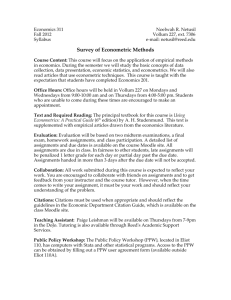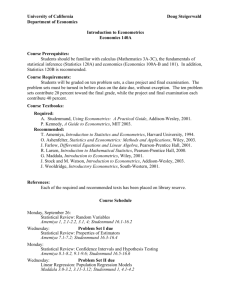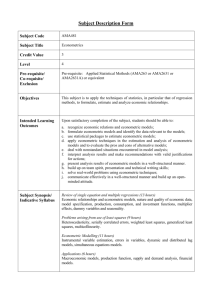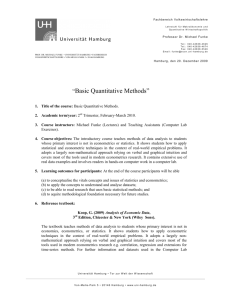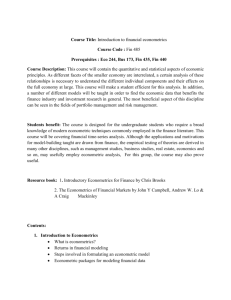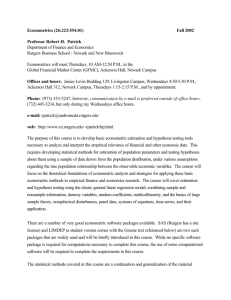ECON107 Applied Econometrics (1410) - Yu Jun
advertisement
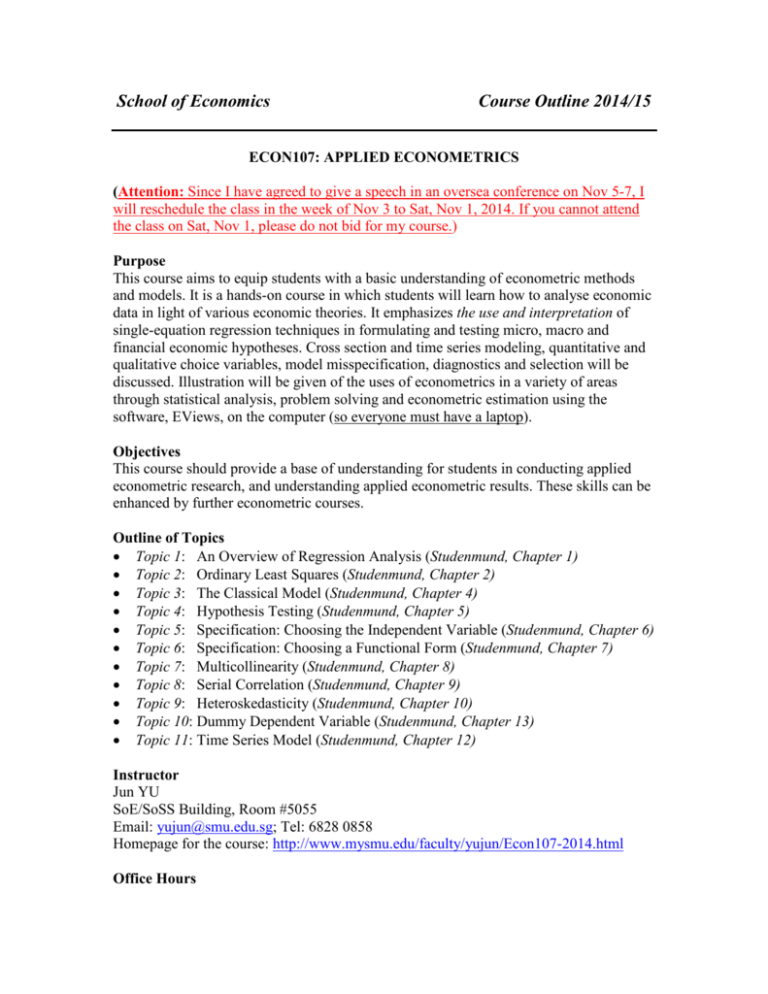
School of Economics Course Outline 2014/15 ECON107: APPLIED ECONOMETRICS (Attention: Since I have agreed to give a speech in an oversea conference on Nov 5-7, I will reschedule the class in the week of Nov 3 to Sat, Nov 1, 2014. If you cannot attend the class on Sat, Nov 1, please do not bid for my course.) Purpose This course aims to equip students with a basic understanding of econometric methods and models. It is a hands-on course in which students will learn how to analyse economic data in light of various economic theories. It emphasizes the use and interpretation of single-equation regression techniques in formulating and testing micro, macro and financial economic hypotheses. Cross section and time series modeling, quantitative and qualitative choice variables, model misspecification, diagnostics and selection will be discussed. Illustration will be given of the uses of econometrics in a variety of areas through statistical analysis, problem solving and econometric estimation using the software, EViews, on the computer (so everyone must have a laptop). Objectives This course should provide a base of understanding for students in conducting applied econometric research, and understanding applied econometric results. These skills can be enhanced by further econometric courses. Outline of Topics • Topic 1: An Overview of Regression Analysis (Studenmund, Chapter 1) • Topic 2: Ordinary Least Squares (Studenmund, Chapter 2) • Topic 3: The Classical Model (Studenmund, Chapter 4) • Topic 4: Hypothesis Testing (Studenmund, Chapter 5) • Topic 5: Specification: Choosing the Independent Variable (Studenmund, Chapter 6) • Topic 6: Specification: Choosing a Functional Form (Studenmund, Chapter 7) • Topic 7: Multicollinearity (Studenmund, Chapter 8) • Topic 8: Serial Correlation (Studenmund, Chapter 9) • Topic 9: Heteroskedasticity (Studenmund, Chapter 10) • Topic 10: Dummy Dependent Variable (Studenmund, Chapter 13) • Topic 11: Time Series Model (Studenmund, Chapter 12) Instructor Jun YU SoE/SoSS Building, Room #5055 Email: yujun@smu.edu.sg; Tel: 6828 0858 Homepage for the course: http://www.mysmu.edu/faculty/yujun/Econ107-2014.html Office Hours TBA or by appointment at SoE/SoSS Building, Room #5055 TA and TA’s Office Hours TBA Prescribed Text A.H. Studenmund, Using Econometrics: A Practical Guide, 6th edition, Addison Wesley, Longman 2011. (This is the cover page of the book) This is a required textbook. There will be regular use of this book for lectures. A useful website related to the textbook is http://occawlonline.pearsoned.com/bookbind/pubbooks/studenmund_awl/ In addition to the textbook, I provide a set of lecture notes, one for each chapter. These notes can be best viewed as a condensed version of the textbook. Every week you should read the note before you attend the lecture. Although the lecture notes are self-contained and highly useful studying material, students will find it essential for success in the course to regularly follow the textbook reading and applications on the topic covered. In addition, one set of tutorial questions will be provided for each topic. The notes are available from the course homepage. Computing Needs Applications require running the software Eviews which is available from SMU network at \\fs21\Applications\PC_Software_Image\Student\EViews8). Supplementary Books R.R. Johnson, A Guide to Using Eviews with Using Econometrics: A Practical Guide This guide demonstrates how to use Eviews to complete econometric analysis illustrated in the textbook by Studenmund. It serves as an alternative to Eviews User’s Guide and is sufficient for this course. The PDF file of this guide is available from the course homepage. We will go over the relevant chapters of this guide during the weekly computer sessions, so you should read the relevant chapters of the guide before you come to the computer sessions. D.N. Gujarati, Essentials of Econometrics, 4nd edition, McGraw Hill Assessment Class participation: 10% (it depends on your attendance of classes, interaction with the professor in the classroom and the performance of in-class quiz at randomly chosen time) Individual assignments and individual project: 30% Group project: 25% Final examination (2 hours): 35% Progression Prerequisites: Core001, Math001, and Stat101
